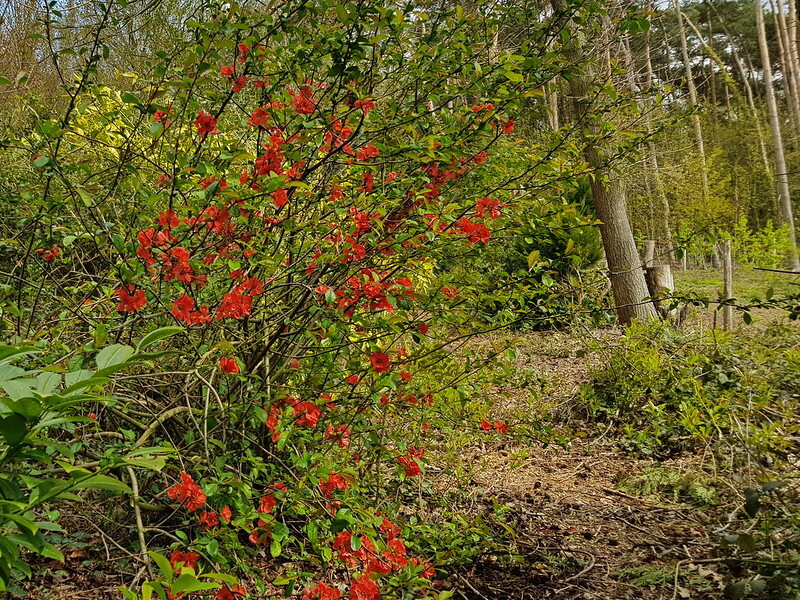Flowering Quince is one of the most vibrant spring shrubs and will produce a crop of dense fruit perfect for making thick jams and interesting pies and cakes. Even during cold spring weather, this hardy shrub erupts into a mass of brilliant color for a few weeks. Flowering Quince develops a sprawling, open form and makes a nice addition to an informal mixed hedge or border. It also makes a colorful backdrop for early spring bulbs. The spiny branches are useful for deterring unwanted wildlife or intruders near a home.

Flowering quince is suitable for growing in temperate climates and is fully winter hardy down to USDA zone 4a. It will flower and fruit well in full sun to part shade and grows fine in clay, silty, sandy, or loamy soil. Flowering quince is not demanding about the soil pH, but dislikes high alkalinity. Fertilizing is only required once a year and is best done after flowering and before fruit set. Use a granular balanced fertilizer with either a 5-5-5 or 10-10-10 NPK ratio.
Flowering quince can reach 3 to 10 feet tall and wide, depending on the variety or cultivar. Prune out any unwanted suckers from below soil level early and often during the growing season. Pruning for shape is done after flowering, as these shrubs bloom on the previous year's growth. This pruning will remove potential fruit, so it is best done every 3-4 years if you wish to have a full crop of fruit in the years between.
Shrubs To Plant With Flowering Quince
For a beautiful flowering hedge, plant flowering quince with other spring bloomers. Purely ornamental shrubs such as forsythia, mock orange, eastern or western redbud, azalea, kerria, and purple sand cherry make wonderful contrasts to the intensely hued quince flowers and extend the flowering period in your garden. Flowering quince also makes a natural companion to other edible small trees and shrubs like dwarf apples, pears, or plum trees. Later summer-blooming or broadleaf evergreen shrubs to consider include smoke bush, holly, viburnum, and arborvitae.

Perennials To Plant With Flowering Quince
The open and spreading growth habit of flowering quince gives it an informal and almost wild appearance. Use it as a nice backdrop for a naturalistic and less formal garden border containing a mix of clumping ornamental grasses, cranesbill, and lady’s mantle. Include a ground cover of bright creeping Jenny to anchor the planting. The bloom time of early bulbs such as grape hyacinth, tulips, daffodils, and hyacinth overlaps with flowering quince and adds additional color. For contrasting texture, include hellebores, which have deep green, palmate, evergreen foliage. Choose several varieties with staggered bloom times from late winter to late spring.

Photo by Rictor Norton & David Allen, unmodified, Flickr, copyright CC BY 2.0
Annuals To Plant With Flowering Quince
Hardy annuals are a great way to add a riot of color under shrubs for a short period. The colors of pansy, violas, primrose, and sweet alyssum provide contrast against the peachy colors of flowering quince for an eclectic look. Annuals also give a gardener the power to change the look and overall aesthetic of a garden bed from year to year. Use the annuals as a temporary filler and weed suppressant until immature perennials reach their ultimate size.
Best Companion Plants for Flowering Quince in Containers
Flowering quince has the ability to grow to the size of its container. Large planters with extra room around the edges can accommodate a few shallow-rooted annuals and perennials around the quince. Use calibrachoa, ornamental sweet potato vine, or bacopa as spiller plants to soften the edges of the container. Check for watering every couple of days and only let the top 4-5 inches of potting mix dry. Fertilize once a month with a top-dressing of a granular, balanced feed. Flowering quince is also popular for bonsai and can be extremely long lived when the roots are pruned regularly.
Plants Not To Grow With Flowering Quince
Even though flowering quince adapts to many different soil types, it requires excellent drainage year-round to live a long life. Plants that prefer or need to be submerged in water and heavy silty soil like flag Iris, pickerel rush, and Egyptian papyrus reed do not grow well with flowering quince in dry, well-drained soil.
Best Plants To Grow With Flowering Quince
Flowering Quince is in its full glory very early in the spring. Flowers in bright coral or red erupt from bare stems to mark the beginning of the season. The best plants to combine with flowering quince are other spring-blooming shrubs such as rhododendron, forsythia, and daphne. Plant a bed of daffodils, tulips, early ornamental alliums, and hyacinths under flowering quince to provide a colorful ground cover effect. The bulbs’ foliage dies back early in the summer and can be covered with an organic mulch for the rest of the year.
Sources: “Chaenomeles speciosa.” North Carolina State Extension Plant Toolbox. plants.ces.ncsu.edu
